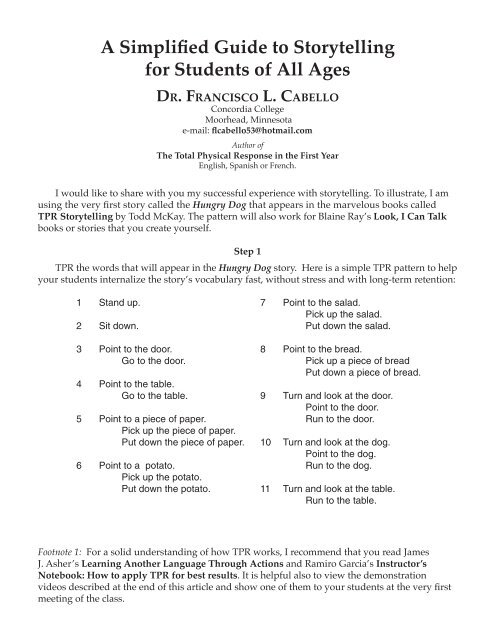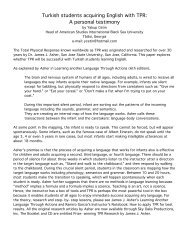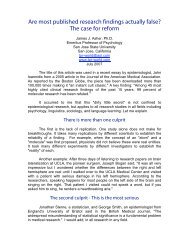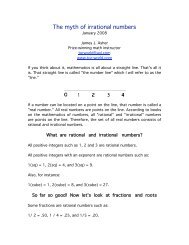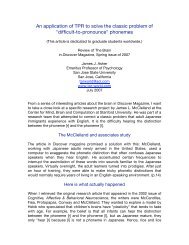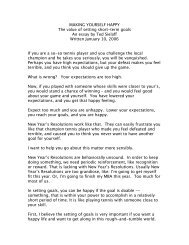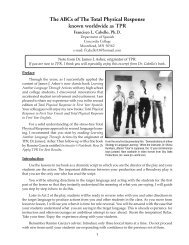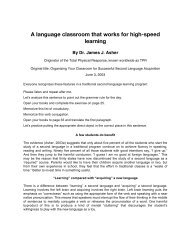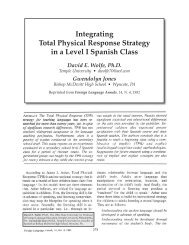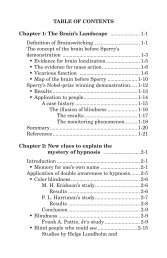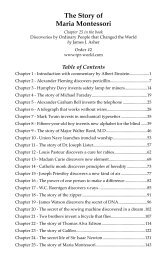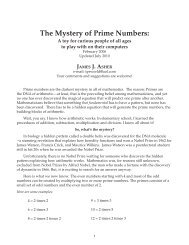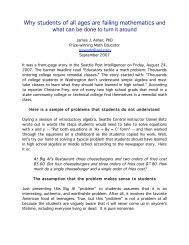A Simplified Guide to Storytelling for Students of All Ages - TPR World
A Simplified Guide to Storytelling for Students of All Ages - TPR World
A Simplified Guide to Storytelling for Students of All Ages - TPR World
You also want an ePaper? Increase the reach of your titles
YUMPU automatically turns print PDFs into web optimized ePapers that Google loves.
A <strong>Simplified</strong> <strong>Guide</strong> <strong>to</strong> S<strong>to</strong>rytelling<br />
<strong>for</strong> <strong>Students</strong> <strong>of</strong> <strong>All</strong> <strong>Ages</strong><br />
Dr. Francisco L. Cabello<br />
Concordia College<br />
Moorhead, Minnesota<br />
e-mail: flcabello53@hotmail.com<br />
Author <strong>of</strong><br />
The Total Physical Response in the First Year<br />
English, Spanish or French.<br />
I would like <strong>to</strong> share with you my successful experience with s<strong>to</strong>rytelling. To illustrate, I am<br />
using the very first s<strong>to</strong>ry called the Hungry Dog that appears in the marvelous books called<br />
<strong>TPR</strong> S<strong>to</strong>rytelling by Todd McKay. The pattern will also work <strong>for</strong> Blaine Ray’s Look, I Can Talk<br />
books or s<strong>to</strong>ries that you create yourself.<br />
Step 1<br />
<strong>TPR</strong> the words that will appear in the Hungry Dog s<strong>to</strong>ry. Here is a simple <strong>TPR</strong> pattern <strong>to</strong> help<br />
your students internalize the s<strong>to</strong>ry’s vocabulary fast, without stress and with long-term retention:<br />
1 Stand up.<br />
2 Sit down.<br />
3 Point <strong>to</strong> the door.<br />
Go <strong>to</strong> the door.<br />
4 Point <strong>to</strong> the table.<br />
Go <strong>to</strong> the table.<br />
5 Point <strong>to</strong> a piece <strong>of</strong> paper.<br />
Pick up the piece <strong>of</strong> paper.<br />
Put down the piece <strong>of</strong> paper.<br />
6 Point <strong>to</strong> a pota<strong>to</strong>.<br />
Pick up the pota<strong>to</strong>.<br />
Put down the pota<strong>to</strong>.<br />
7 Point <strong>to</strong> the salad.<br />
Pick up the salad.<br />
Put down the salad.<br />
8 Point <strong>to</strong> the bread.<br />
Pick up a piece <strong>of</strong> bread<br />
Put down a piece <strong>of</strong> bread.<br />
9 Turn and look at the door.<br />
Point <strong>to</strong> the door.<br />
Run <strong>to</strong> the door.<br />
10 Turn and look at the dog.<br />
Point <strong>to</strong> the dog.<br />
Run <strong>to</strong> the dog.<br />
11 Turn and look at the table.<br />
Run <strong>to</strong> the table.<br />
Footnote 1: For a solid understanding <strong>of</strong> how <strong>TPR</strong> works, I recommend that you read James<br />
J. Asher’s Learning Another Language Through Actions and Ramiro Garcia’s Instruc<strong>to</strong>r’s<br />
Notebook: How <strong>to</strong> apply <strong>TPR</strong> <strong>for</strong> best results. It is helpful also <strong>to</strong> view the demonstration<br />
videos described at the end <strong>of</strong> this article and show one <strong>of</strong> them <strong>to</strong> your students at the very first<br />
meeting <strong>of</strong> the class.
Step 2<br />
Now your students, <strong>of</strong> all ages including adults, are ready <strong>to</strong> hear you tell a short s<strong>to</strong>ry about<br />
the Hungry Dog pointing <strong>to</strong> each picture below as you talk.<br />
I recommend that you do not read the s<strong>to</strong>ry but tell the s<strong>to</strong>ry in a conversational <strong>to</strong>ne as you<br />
look and point <strong>to</strong> each picture. It is not necessary that you tell the s<strong>to</strong>ry exactly as it appears in<br />
the book. What matters is that the s<strong>to</strong>ry sounds natural. Remember, you are telling the s<strong>to</strong>ry, not<br />
reading it.<br />
A<br />
B<br />
C<br />
D<br />
Here is my version <strong>of</strong> the s<strong>to</strong>ry:<br />
Eugene pushes a shopping cart in<strong>to</strong> the supermarket, Pueblo. He looks at a pota<strong>to</strong> and puts<br />
it in<strong>to</strong> his shopping cart. It is 9:30 in the morning. When he gets home, he puts everything on the<br />
kitchen table. The dog comes running <strong>to</strong> the table. Eugene is shocked because the dog sits on a<br />
s<strong>to</strong>ol and eats a piece <strong>of</strong> bread.<br />
Notice that in the <strong>TPR</strong> experience, your students have not heard some <strong>of</strong> the words in the<br />
s<strong>to</strong>ry such as “shopping cart,” “supermarket,” “9:30 in the morning,” “kitchen,” or “s<strong>to</strong>ol.” It is<br />
OK because they have enough vocabulary <strong>to</strong>gether with the picture <strong>to</strong> discern the meaning.<br />
Footnote 2: Just <strong>to</strong> show you that the possibilities are endless, here are other details <strong>of</strong> the s<strong>to</strong>ry<br />
I could have used: Eugene has a funny haircut. He has big eyes and is wearing a striped shirt.<br />
He is pushing a shopping cart in<strong>to</strong> the supermarket.
Step 3<br />
Now you have some interesting options. One possibility is <strong>to</strong> tell the s<strong>to</strong>ry a second time, this<br />
time adding some gestures (See McKay’s Teacher’s <strong>Guide</strong>book <strong>for</strong> a list <strong>of</strong> gestures or order his<br />
demonstration video by going <strong>to</strong> www.tpr-world.com)<br />
Another possibility is <strong>to</strong> dramatize the s<strong>to</strong>ry with your students, each <strong>of</strong> whom take a<br />
different role. You narrate the s<strong>to</strong>ry and your students act out their parts.<br />
Still another possibility is <strong>to</strong> give a simple true-false test <strong>to</strong> assess understanding such as:<br />
1. The boy’s name is Eugene.<br />
2. He is going in<strong>to</strong> a drug s<strong>to</strong>re.<br />
3. He puts a pota<strong>to</strong> in<strong>to</strong> his shopping cart.<br />
4. He puts everything on the kitchen table.<br />
5. His dog’s name is Fido.<br />
Yet another possibility is <strong>to</strong> describe each frame, but out <strong>of</strong> sequence. The student’s task is <strong>to</strong><br />
decide which frame you are describing: A, B, C, or D.<br />
Another option is this: Tell the s<strong>to</strong>ry again, but leave out a word that the student must fill in.<br />
Select a student whose hand is up. Example:<br />
1. The boy’s name is ____________________<br />
2. He is going <strong>to</strong> the ____________________<br />
3. He buys____________________and ____________________<br />
4. When he returns home, he puts everything on____________________<br />
5. When he returns home, the____________________ runs <strong>to</strong> greet him.<br />
Step 4<br />
Now your students have a chance <strong>to</strong> talk. Looking at the four-panel pictures on a<br />
transparency or in their book, ask your students <strong>to</strong> sit in pairs and tell the s<strong>to</strong>ry <strong>to</strong> each other<br />
while looking at the pictures <strong>for</strong> guidance.<br />
Step 5<br />
Ask <strong>for</strong> volunteers who are willing <strong>to</strong> stand up and tell the s<strong>to</strong>ry <strong>to</strong> the class. Select a student<br />
whose hand is up. Some students will be ready and eager; others are not yet ready, but given<br />
more time, eventually everyone will feel com<strong>for</strong>table telling the s<strong>to</strong>ry.
Step 6<br />
Now <strong>for</strong> some fun and creativity from your students. In McKay’s books, there are four<br />
empty panels in the section called Your Version. Ask your students <strong>to</strong> draw their version <strong>of</strong><br />
the s<strong>to</strong>ry with as many changes as they wish. They can use stick figures if they want <strong>to</strong>. McKay<br />
recommends you play Baroque or Mozart music while they draw. This seems <strong>to</strong> help them<br />
concentrate and be quiet while they draw.<br />
I recommend that you circulate and fill in any new vocabulary that students would like <strong>to</strong><br />
use in their s<strong>to</strong>ries but have not yet experienced.<br />
Finally, each <strong>of</strong> your students gets a chance <strong>to</strong> describe their version <strong>of</strong> the s<strong>to</strong>ry. Get ready<br />
<strong>for</strong> entertainment that no pr<strong>of</strong>essional comedy writer could dream up.<br />
Step 7<br />
Your students are ready successfully <strong>to</strong> do the exercises in their books: Fill-in and True-False<br />
Step 8<br />
The entire class writes another version <strong>of</strong> the s<strong>to</strong>ry with each student contributing a sentence.<br />
As each student utters a sentence in the target language, you write it on the chalkboard and your<br />
students follow along by writing in their notebooks. Notice that without an announcement or<br />
fuss, we have made a quiet, graceful transition in<strong>to</strong> reading and writing. I would recommend<br />
that you not mention reading and writing. If you do, you now alarm the student’s left brain<br />
with, “Oh, oh! This is something new. I don’t know how <strong>to</strong> read and write in Spanish. This will<br />
probably be difficult. I can’t do it!”<br />
Another option here is <strong>to</strong> have each student draw, in four empty frames, the collective<br />
version <strong>of</strong> the s<strong>to</strong>ry that the class created. Collect the s<strong>to</strong>ries drawn and written by each student.<br />
Take them home and study them <strong>to</strong> find the best versions.<br />
In the next meeting, show the class some <strong>of</strong> the best versions created by their classmates.<br />
Read them and praise their ef<strong>for</strong>ts. You may want <strong>to</strong> return one s<strong>to</strong>ry <strong>to</strong> the author and ask the<br />
student <strong>to</strong> read aloud his or her version. Continue doing this. Do not return all the s<strong>to</strong>ries at once.<br />
Step 9<br />
It is test time. One option is <strong>to</strong> select a test from Todd McKay’s <strong>TPR</strong> S<strong>to</strong>rytelling Test Packet<br />
or from Blaine Ray’s Teacher’s <strong>Guide</strong>book <strong>for</strong> Look, I Can Talk.<br />
Another option: You create a simple s<strong>to</strong>ry from the vocabulary your students have now<br />
acquired. In four empty panels, ask your students <strong>to</strong> draw a picture in each frame <strong>to</strong> illustrate<br />
each part <strong>of</strong> the s<strong>to</strong>ry.<br />
There you have all the secrets <strong>for</strong> success that I have discovered. If you have found some tips<br />
and tricks that I missed about s<strong>to</strong>rytelling, please share them with me by e-mail. I appreciate it. I<br />
welcome your comments and suggestions.<br />
Edi<strong>to</strong>r’s note—<br />
Risks <strong>of</strong> teaching <strong>to</strong> the left brain<br />
Most traditional approaches <strong>to</strong> language learning start on the left side <strong>of</strong> the brain by asking students<br />
<strong>to</strong> speak on cue in the very first meeting <strong>of</strong> the class with a request such as, “Listen and repeat after me.”<br />
Afterall, the language is transparent <strong>to</strong> the teacher. It seems reasonable that it will also be transparent <strong>to</strong> the<br />
student if they only, “Pay attention. Listen and repeat after me.”
The left brain strategy does not work. Eventually, 95 percent <strong>of</strong> the students lose interest. Asking<br />
students, especially beginners, <strong>to</strong> produce utterances in an alien language on cue is “brain antagonistic”<br />
instruction with high stress, slow-motion learning word-by-word, and resistance <strong>to</strong> s<strong>to</strong>ring the material in<br />
memory. <strong>All</strong> <strong>of</strong> our research shows that it takes a special preparation on the right side <strong>of</strong> the brain with <strong>TPR</strong><br />
<strong>to</strong> get your students ready <strong>for</strong> speaking, reading and writing.<br />
Here is another stressful left brain approach <strong>to</strong> learning: Asking students <strong>to</strong> memorize anything will<br />
require multiple trials because the left brain does not like novelty if there is any risk <strong>of</strong> harm or if the<br />
in<strong>for</strong>mation is perceived as a lie. For example, if the instruc<strong>to</strong>r asserts that “This is a reshal; this is a murra;<br />
and this is a taula,” the left brain erases that strange vocabulary in the alien language almost be<strong>for</strong>e students<br />
stand <strong>to</strong> leave the class. The reason: The student’s left brain concludes: “Only one person in this room<br />
believes those assertions <strong>to</strong> be true; thirty other people know that ‘This is a man, this is a woman and that<br />
is a table.’”<br />
The left brain is a gatekeeper <strong>to</strong> keep us safe and sane by doing what is familiar. “Better <strong>to</strong> be safe than<br />
sorry.” “Stick with the tried and the true.” There is safety in being a “creature <strong>of</strong> habit.” Since the mission <strong>of</strong><br />
“school” is <strong>to</strong> change people, and teachers are agents <strong>of</strong> the school, it is not surprising that the student’s left<br />
brain is suspicious and skeptical.<br />
To insure success with anything novel such as new vocabulary or a new grammatical structure, I<br />
recommend playing <strong>to</strong> the right brain so that your students and you can enjoy “brain compatible” instruction<br />
with powerful techniques such as <strong>TPR</strong> followed by s<strong>to</strong>rytelling, games, skits, and songs. For full details <strong>of</strong><br />
the amazing left and right brain, see James J. Asher’s books listed below and on the following pages.<br />
Asher, James J. (2003).<br />
Asher, James J. (2002).<br />
Asher, James J. (2000).<br />
Cabello, Francisco (2004).<br />
Recommended follow-up reading<br />
Learning Another Language Through Actions (6th edition).<br />
Los Ga<strong>to</strong>s, CA: Sky Oaks Productions, Inc.<br />
Brainswitching: Learning on the right side <strong>of</strong> the brain.<br />
Los Ga<strong>to</strong>s, CA: Sky Oaks Productions, Inc.<br />
The Super School: Teaching on the right side <strong>of</strong> the brain.<br />
Los Ga<strong>to</strong>s, CA: Sky Oaks Productions, Inc.<br />
<strong>TPR</strong> in First Year English. (Also available in Spanish and French).<br />
Los Ga<strong>to</strong>s, CA: Sky Oaks Productions, Inc.<br />
Chris<strong>to</strong>pherson, Joan. (2005). A Language Classroom That Works <strong>for</strong> High-Speed Learning!<br />
Los Ga<strong>to</strong>s, CA: Sky Oaks Productions, Inc.<br />
Garcia, Ramiro. (2001).<br />
McKay, Todd. (2004).<br />
Ray, Blaine. (2005).<br />
Schessler, Eric. (1999).<br />
Instruc<strong>to</strong>r’s Notebook: How <strong>to</strong> apply <strong>TPR</strong> <strong>for</strong> best results (4th edition).<br />
Los Ga<strong>to</strong>s, CA: Sky Oaks Productions, Inc.<br />
<strong>TPR</strong> S<strong>to</strong>rytelling<br />
(Available in English, Spanish or French).<br />
Los Ga<strong>to</strong>s, CA: Sky Oaks Productions, Inc.<br />
Look, I Can Talk series (Available in English, Spanish, French or German).<br />
Los Ga<strong>to</strong>s, CA: Sky Oaks Productions, Inc.<br />
English Grammar through Actions: How <strong>to</strong> <strong>TPR</strong> 50 grammatical features in<br />
English. (Also available in Spanish or French).<br />
Los Ga<strong>to</strong>s, CA: Sky Oaks Productions, Inc.<br />
Seely, Contee and Elizabeth Romijn. (2002) <strong>TPR</strong> is More than Commands — At <strong>All</strong> Levels.<br />
Los Ga<strong>to</strong>s, CA: Sky Oaks Productions, Inc.<br />
Silver, Stephen. (2003).<br />
Silver, Stephen. (1986).<br />
Listen and Per<strong>for</strong>m series (Available in English, Spanish or French).<br />
Los Ga<strong>to</strong>s, CA: Sky Oaks Productions, Inc.<br />
The Command Book: How <strong>to</strong> <strong>TPR</strong> 2,000 vocabulary items in any language.<br />
Los Ga<strong>to</strong>s, CA: Sky Oaks Productions, Inc.
Dear Colleague:<br />
I want <strong>to</strong> share with you the <strong>TPR</strong> Lessons<br />
that my high school and college students<br />
have thoroughly enjoyed and retained <strong>for</strong><br />
weeks—even months later. My book has…<br />
• A script you may follow step-by-step<br />
including a list <strong>of</strong> props needed <strong>to</strong> conduct<br />
each class.<br />
• A command <strong>for</strong>mat that students thoroughly enjoy. (<strong>Students</strong><br />
show their understanding <strong>of</strong> the spoken language by successfully<br />
carrying out the commands given <strong>to</strong> them by the instruc<strong>to</strong>r.<br />
Production is delayed until students are ready and feel<br />
com<strong>for</strong>table.)<br />
• Grammar taught implicitly through the imperative.<br />
• Tests <strong>for</strong> an evaluation <strong>of</strong> student achievement.<br />
Sincerely,<br />
Francisco Cabello, Ph.D.<br />
TOTAL<br />
PHYSICAL<br />
RESPONSE<br />
IN<br />
THE<br />
FIRST YEAR<br />
By<br />
FRANCISCO L. CABELLO<br />
with William Denevan<br />
Order # | Title:<br />
221 | <strong>TPR</strong> in First Year English<br />
220 | <strong>TPR</strong> in First Year Spanish<br />
222 | <strong>TPR</strong> in First Year French<br />
The latest books by James J. Asher<br />
Award-winning Teacher, Researcher, and Writer;<br />
Origina<strong>to</strong>r <strong>of</strong> the Total Physical Response - known worldwide as <strong>TPR</strong><br />
Learning Another Language Through Actions (6th Ed.) - Order #201<br />
• Demonstrates step-by-step how <strong>to</strong> apply <strong>TPR</strong> <strong>to</strong> help children and adults<br />
acquire another language without stress.<br />
• 150 hours <strong>of</strong> classroom-tested <strong>TPR</strong> lessons - can be applied <strong>to</strong> any language!<br />
• Behind the scenes look at how <strong>TPR</strong> was developed.<br />
• Answers more than 100 frequently asked questions about <strong>TPR</strong>.<br />
Brainswitching: Learning on the Right Side <strong>of</strong> the Brain (2nd Edition) - Order #202<br />
For fast, stress-free access <strong>to</strong> languages, mathematics, science, and much, much more!<br />
The Super School: Teaching on the Right Side <strong>of</strong> the Brain - Order #204<br />
• James J. Asher shows how the magic <strong>of</strong> <strong>TPR</strong> can be applied <strong>to</strong> improve every feature <strong>of</strong><br />
<strong>to</strong>day’s schools.<br />
• Shows how <strong>to</strong> help your students learn anything fast in academics, sports, or technology!<br />
• Your students won’t want <strong>to</strong> miss a single class!<br />
• Must-read <strong>for</strong> administra<strong>to</strong>rs and teachers, as well as parents and home-schoolers!<br />
• Appropriate <strong>for</strong> all languages and all ages.<br />
New DVD! Introduction <strong>to</strong> <strong>TPR</strong> - Order #409-DVD<br />
Exciting personal demonstration <strong>of</strong> <strong>TPR</strong> narrated in English by Dr. James J. Asher followed by a lively<br />
Q & A with FL/ESL instruc<strong>to</strong>rs.
New!<br />
James J. Asher’s<br />
Prize-Winning <strong>TPR</strong> Research<br />
For the first time collected in one place on a CD, the complete prize-winning body <strong>of</strong> research by<br />
James J. Asher. Booklet available with the CD gives Asher’s comments on each study with recommendations<br />
<strong>for</strong> future research. Saves you weeks <strong>of</strong> searching the internet or library.<br />
• Shows step-by-step how Asher planned and successfully completed each research study.<br />
• Includes all <strong>of</strong> Asher’s pioneer studies in second language learning.<br />
• Also includes Asher’s work in industrial psychology: problem solving, creativity, hiring, training,<br />
aptitude testing, and designing the world’s first au<strong>to</strong>mated postal distribution center.<br />
Order#<br />
Title<br />
7 Prize-Winning <strong>TPR</strong> Research Booklet and CD<br />
New! James J. Asher’s<br />
Brains<strong>to</strong>rming Kit<br />
• Booklet and Transparencies with step-by-step directions <strong>to</strong> guide your group.<br />
• Help your group understand what <strong>to</strong> do and why they are doing it.<br />
• Discover options you never thought possible—and it’s a lot <strong>of</strong> fun, <strong>to</strong>o!<br />
Order#<br />
Title<br />
8 Brains<strong>to</strong>rming Kit - Booklet & Transparencies<br />
Trans<strong>for</strong>ms ordinary committee meetings in<strong>to</strong><br />
high-powered problem solving sessions!<br />
Best Demonstrations <strong>of</strong> Classic <strong>TPR</strong> Anywhere in the <strong>World</strong>!<br />
James J. Asher’s Classic Videos demonstrate the original research…<br />
His<strong>to</strong>ric videos show the original <strong>TPR</strong> research by Dr. James J. Asher with children and adults learning<br />
Japanese, Spanish, French and German. These vintage demonstrations are time-tested, and even more valid<br />
<strong>to</strong>day than when the film was shot decades ago. (Each video is narrated in English.)<br />
We include with every video a copy <strong>of</strong> the scientific publications documenting the amazing results you<br />
will see. A must <strong>for</strong> anyone teaching <strong>TPR</strong>. Each video is unique, and shows different stress-free features <strong>of</strong> <strong>TPR</strong><br />
instruction — no matter what language you are teaching, including English as a Second Language.<br />
Children Learning Another Language:<br />
An Innovative Approach ©<br />
Color, 26 minutes, shows the excitement <strong>of</strong> children from K through<br />
6th grades as they acquire Spanish and French with <strong>TPR</strong>.<br />
Research published in Child Development. 1977, 48, 1040-1048:<br />
“Children Learning Another Language: A Developmental Hypothesis.”<br />
Order Number 435-VHS<br />
Order Number 435-DVD<br />
Demonstration <strong>of</strong> a New Strategy in Language Learning ©<br />
B&W, 15 minutes, shows American children acquiring Japanese<br />
with <strong>TPR</strong>. Applies <strong>to</strong> any language!<br />
Research published in the International Review <strong>of</strong> Applied Linguistics,<br />
Volume III/4, 1965. “The Strategy <strong>of</strong> the Total Physical Response: An<br />
Application <strong>to</strong> Learning Japanese.”<br />
Order Number 408-VHS<br />
Order Number 408-DVD<br />
<br />
A Motivational Strategy <strong>for</strong> Language Learning ©<br />
Color, 25 minutes, demonstrates step-by-step how <strong>to</strong> apply <strong>TPR</strong> <strong>for</strong> best<br />
results with students between the ages <strong>of</strong> 17 and 60 acquiring Spanish. Easy <strong>to</strong><br />
see how <strong>TPR</strong> can be used <strong>to</strong> teach any target language.<br />
Research published in The Modern Language Journal, Vol. LVIII, No. 1-2, Jan-Feb<br />
1974. “Learning A Second Language Through Commands: The Second field Test.”<br />
Order Number 406-VHS<br />
Order Number 406-DVD<br />
Strategy <strong>for</strong> Second Language Learning ©<br />
Color, 19 minutes, shows students from 17 <strong>to</strong> 60 acquiring German with <strong>TPR</strong>.<br />
Applies <strong>to</strong> any language!<br />
Research published in The Modern Language Journal, Vol. LVI, No. 3, March,<br />
1972. “Children’s First Language as a Model <strong>for</strong> Second Language Learning.”<br />
Order Number 407-VHS<br />
Order Number 407-DVD
<strong>TPR</strong> S<strong>to</strong>rytelling<br />
by<br />
Todd McKay<br />
✔ Pre-tested in the classroom <strong>for</strong> 8 years <strong>to</strong> guarantee<br />
success <strong>for</strong> your students.<br />
✔ Easy <strong>to</strong> follow, step-by-step guidance each day<br />
<strong>for</strong> three school years - one year at a time.<br />
✔ Todd shows you how <strong>to</strong> switch from activity <strong>to</strong><br />
activity <strong>to</strong> keep the novelty alive <strong>for</strong> your students<br />
day after day.<br />
✔ Evidence shows the approach works: <strong>Students</strong><br />
in s<strong>to</strong>rytelling class outper<strong>for</strong>med students in<br />
the traditional ALM class.<br />
✔ Each s<strong>to</strong>ry comes illustrated with snazzy car<strong>to</strong>ons<br />
that appeal <strong>to</strong> students <strong>of</strong> all ages.<br />
✔ There is continuity <strong>to</strong> the s<strong>to</strong>ry line because the<br />
s<strong>to</strong>ries revolve around one family.<br />
✔ Complete with tests <strong>to</strong> assess comprehension,<br />
speaking, reading and writing.<br />
✔ Yes, cultural <strong>to</strong>pics are included.<br />
✔ Yes, s<strong>to</strong>ries include most <strong>of</strong> the content you will<br />
find in traditional textbooks including vocabulary<br />
and grammar.<br />
✔ Yes, included is a brief refresher <strong>of</strong> classic <strong>TPR</strong>,<br />
by the origina<strong>to</strong>r—<br />
Dr. James J. Asher.<br />
✔ Yes, games are included.<br />
✔ Yes, your students will have the long-term retention<br />
you expect from <strong>TPR</strong> instructions.<br />
✔ Yes, Todd includes his e-mail address <strong>to</strong> answer<br />
your questions if you get stuck along the way.<br />
✔ Yes, you can order a video demonstration showing<br />
you step-by-step how <strong>to</strong> apply every feature<br />
in the Teacher’s <strong>Guide</strong>book.<br />
Sky Oaks Productions, Inc.<br />
P.O. Box 1102 • Los Ga<strong>to</strong>s, CA, USA 95031<br />
Phone: (408) 395-7600 • Fax: (408) 395-8440<br />
e-mail: tprworld@aol.com<br />
www.tpr—world.com<br />
Cali<strong>for</strong>nia residents: add sales tax. Prices subject <strong>to</strong> change without notice.<br />
USA: Add 10% <strong>for</strong> S & H (minimum: $4.75)<br />
Outside USA: <strong>for</strong> S&H add 20% <strong>for</strong> surface mail OR 35% <strong>for</strong> airmail (minimum: $9.95)<br />
Use your VISA, MasterCard, or Discover Card <strong>to</strong> order from anywhere in the world!<br />
WE SHIP ASAP! FREE <strong>TPR</strong> Catalog upon request!<br />
Order<br />
Number Title<br />
400 Student Book - Year 1 English<br />
401 Student Book - Year 2 English<br />
402 Student Book - Year 3 English<br />
410 Student Book - Year 1 Spanish<br />
411 Student Book - Year 2 Spanish<br />
412 Student Book - Year 3 Spanish<br />
420 Student Book - Year 1 French<br />
421 Student Book - Year 2 French<br />
422 Student Book - Year 3 French<br />
430 Complete Testing Packet <strong>for</strong> English<br />
Listening, Reading, Speaking, and Writing<br />
431 Complete Testing Packet <strong>for</strong> Spanish<br />
Listening, Reading, Speaking, and Writing<br />
432 Complete Testing Packet <strong>for</strong> French<br />
Listening, Reading, Speaking, and Writing<br />
440 Teacher’s <strong>Guide</strong>book <strong>for</strong> English<br />
441 Teacher’s <strong>Guide</strong>book <strong>for</strong> Spanish<br />
442 Teacher’s <strong>Guide</strong>book <strong>for</strong> French<br />
450 Transparencies <strong>for</strong> <strong>All</strong> Languages - Year 1<br />
451 Transparencies <strong>for</strong> <strong>All</strong> Languages - Year 2<br />
452 Transparencies <strong>for</strong> <strong>All</strong> Languages - Year 3<br />
460 <strong>TPR</strong> S<strong>to</strong>rytelling Video<br />
Shows every step in the Teacher’s <strong>Guide</strong>book.<br />
Exciting new products from Todd McKay!<br />
<strong>TPR</strong> Index Cards<br />
(Easy-<strong>to</strong>-handle 4x5 cards)<br />
1. Index cards tell you exactly what <strong>to</strong> say, lesson by lesson.<br />
2. 60 Cards with vocabulary from First Year textbooks.<br />
3. When your students internalize this vocabulary, they’re<br />
ready <strong>for</strong> a smooth transition <strong>to</strong> s<strong>to</strong>ries.<br />
4. No need <strong>to</strong> fumble through a book.<br />
5. No need <strong>to</strong> make up your own lessons.<br />
6. Quick! Easy <strong>to</strong> use! Classroom-tested <strong>for</strong> success!<br />
7. Works <strong>for</strong> students <strong>of</strong> all ages, including adults!<br />
470 <strong>TPR</strong> Index Cards <strong>for</strong> English<br />
471 <strong>TPR</strong> Index Cards <strong>for</strong> Spanish<br />
472 <strong>TPR</strong> Index Cards <strong>for</strong> French<br />
473 <strong>TPR</strong> Index Cards <strong>for</strong> German


